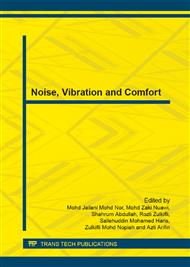[1]
P. Gaspar, I. Szaszi, J. Bokor, Design of robust controllers for active vehicle suspension using the mixed μ synthesis, Vehicle System Dynamics. 40 (2003) 193-228.
DOI: 10.1076/vesd.40.2.193.16541
Google Scholar
[2]
A. Moran, C.M. Nagai, Performance analysis of vehicle active suspension with H∞ robust control, In Proc. 1st International Conference on Motion and Vibration Control (MOVIC), Yokohama (1992) 756- 761.
Google Scholar
[3]
J. H. Park, Y. S. Kim, An H∞ controller for active suspensions and its robustness based on a full-car model, In Proceeding of the 14th World Congress of IFAC (1999) 503-508.
Google Scholar
[4]
A. Kruczek, A. Stribrsky, J. Honcu, M. Hlinovsky, Controller choice for car active suspension, International Journal of Mechanics 3 (2010) 61-68.
Google Scholar
[5]
F. Jamshidi, A. Shaabany, Robust control of an active suspension system using H2 & H∞ control methods, The Journal of American Science 7 (2011) 1-5.
Google Scholar
[6]
S. Chantranuwathana, P. Huei, Force tracking control for active suspensions-theory and experiments, In Control Applications, 1999, Proceedings of the 1999 IEEE International Conference on. 1(1999) 442-447.
DOI: 10.1109/cca.1999.806676
Google Scholar
[7]
M. Kaleemullah, W.F. Faris, F. Hasbullah, Design of robust H1, fuzzy and LQR controller for active suspension of a quarter car model, In Mechatronics (ICOM), 4th International Conference On. (2011) 1-6.
DOI: 10.1109/icom.2011.5937197
Google Scholar
[8]
Y. Shoukry, M. El-Shafie, S. Hammad, Networked embedded generalized predictive controller for an active suspension system, In American Control Conference. (2010) 4570-4575.
DOI: 10.1109/acc.2010.5530876
Google Scholar
[9]
I. Maciejewski, Control system design of active seat suspensions, Journal of Sound and Vibration 331 (2012) 1291-1309.
DOI: 10.1016/j.jsv.2011.11.010
Google Scholar
[10]
X. Shen, H. Peng, Analysis of active suspension systems with hydraulic actuators, In the Dynamics of Vehicles on Roads and on Tracks. Proceedings Of The 18th IAVSD Symposium Held In Kanagawa, Japan. (2004) 143–152.
Google Scholar
[11]
W.S. Aboud, S.M. Haris, A study on load dependent controller performance for mechatronic suspensions, International Review of Mechanical Engineering 6 (2012) 611-616.
Google Scholar


